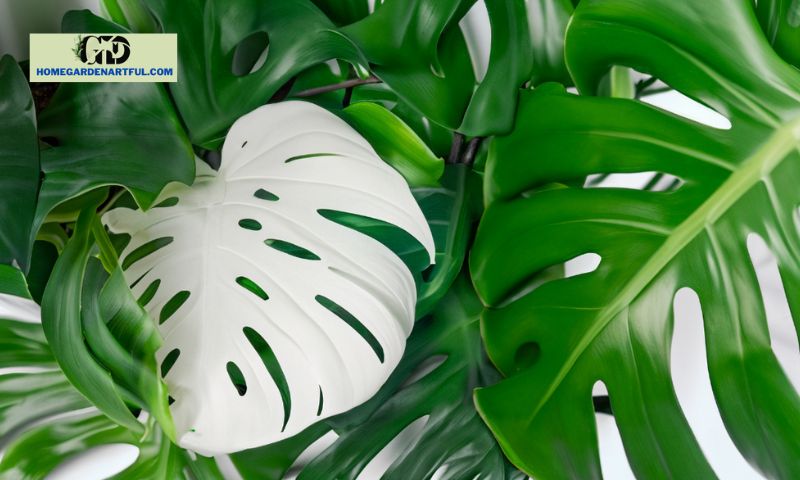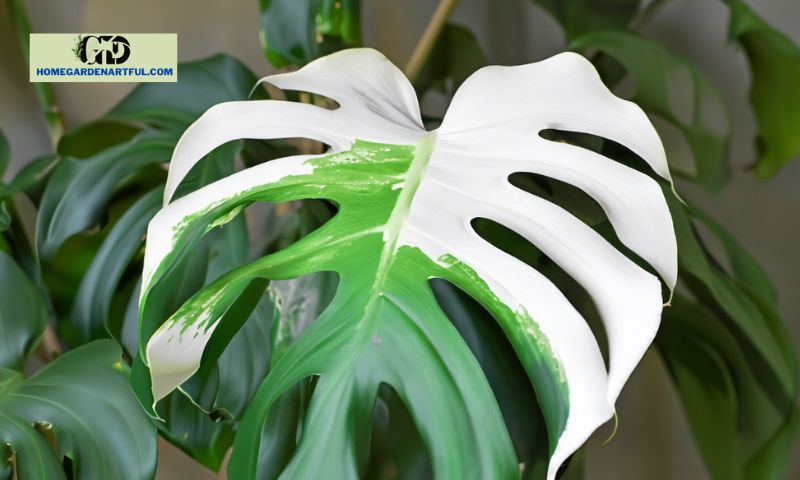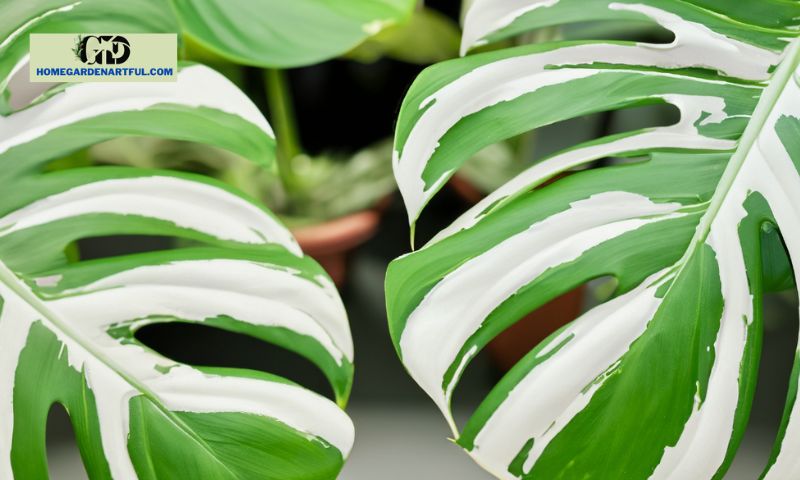The half Moon Monstera plant has certainly been making an appearance on social media and in home décor magazines if you’re interested in interior design. With good cause, this unusual plant is gradually gaining popularity in the interior design industry. Its leaves are an elegant touch that can be added to any setting thanks to their lovely design. At homegardenartful.com, learn more about this interesting plant by reading about, it and discover why it’s such a sought-after item in the interior design industry.
Exploring Half Moon Monstera

A variation of the Monstera Deliciosa, the half-moon Monstera plant is named for its gorgeous leaves. The Half Moon Monstera’s leaves are separated into two sections, each with its own unique hue. The leaf has a conventional green side and a white side.
There is more green on this Monstera than, for instance, an albino Monstera since these hues can be clearly separated or marked with marbling, dots, and streaks of the two tones.
The DNA of the plant has undergone an uncommon and sporadic mutation that is responsible for the patterns. As the plant develops, you can see a shift in the patterning of the leaves due to this unforeseen mutation.
The plant will be more susceptible overall the more white there is on the leaves. This means that the white parts will be the first to exhibit signs of discomfort when exposed to excessive light and dry circumstances.
This is due to the plant’s reduced ability to absorb chlorophyll in these regions, which may prevent the leaves from absorbing as much solar energy. As a result, you could note that particular Monstera has different lighting requirements than other varieties.
Giving your half-moon Monstera bright, indirect light and watering it when the top inch of soil feels dry are the best ways to take care of it. For the plant to flourish, you can fertilize them once or twice a month during the growing season.
Obtaining and Caring for Half Moon Monstera

Only propagation can produce a half-moon in Monstera. You will therefore need to grow a cutting of an existing plant into its own. Cut a stem with at least two leaves on it close to the node in order to accomplish this.
After waiting for the Monstera cutting to form roots, you can cultivate it in water or damp soil. Once the plant has established roots, you can move it into a separate pot and take care of it just like any other Monstera plant.
Because auxins, a type of hormone, are made by the plant at the node, it is crucial that you cut the stem there. Since these hormones are in charge of the plant’s cell proliferation, propagating Monstera without a node would prevent the cutting from growing properly.
Using seeds for proliferation is an unreliable strategy due to the random genetic mutation that causes the whitening of the leaves. This is due to the likelihood that the plants that sprout from these seeds won’t have the parent plant’s eye-catching variegation.
The only real way to ensure that the plant you end up with will have the same lovely leaves as the one you started with is through cuttings. To ensure that the plant has a high chance of growing into a lovely Half Moon Monstera, make sure to select a cutting that possesses both green and white on the leaf.
Where to purchase a half-moon Monstera
You must buy a stem cutting or a completely variegated Monstera plant in order to obtain a half-moon Monstera. These are available for purchase online from a number of merchants, including Etsy and well-known plant nurseries.
Doing your homework to discover a reputable vendor is crucial when shopping for a half-moon Monstera for sale. The reason for this is that there are a lot of scams out there, and you don’t want to get a plant that isn’t what you expected.
Care of Monster Half-Moon

Lighting
Bright, directed light is best for Monster Half Moon growth. Although it can handle some direct sunshine, too much of it can burn the leaves. However, because it requires a lot of light to support its stunning leaf hues, it should constantly be exposed to indirect sunshine. Based on where your home is, decide where to put your plant. It’s crucial to choose a window that lets in the most light. By doing this, it will be possible to preserve the leaves’ original white hue. You can put a shield of glass with a scattering feature to protect the monster from sunburn if the sun is too strong.
Fertilizer
You must fertilize your Monster Half Moon frequently to maintain its health. Utilize a balanced liquid fertilizer every two weeks during the spring and summer growing seasons. Limit the frequency of fertilization to just once a month in the winter. Because too much fertilizer can harm the plant, always follow the directions on the fertilizer package. Applying fertilizer is said to be essential since Monstera needs it to generate the lovely colors of white and green.
Watering
It’s crucial to understand that Monster Half-Moon needs a lot of water, so make sure you give it some every day. When the soil feels dry to the touch, water the plant. Watering may be necessary every day or every other day, depending on the size of the pot. To avoid overwatering, always inspect the soil before watering, but don’t let it go completely dry either.
Because everything depends on the size and age of the plant, each Monster Half-Moon specimen will need a different amount of water. Start watering the plant using a traditional watering schedule, recording everything in a notebook, and then keep an eye on the monster’s health to determine whether or not to change the watering.
Temperature and humidity
High humidity and warm temperatures are preferred by this plant. For Monster Half Moon, a temperature range of 70 to 90 degrees Fahrenheit is excellent. The plant will have a shock if the temperature falls below 60 degrees Fahrenheit, and its leaves will start to turn brown. In addition, for this plant to thrive, sufficient humidity is necessary. Installing an automatic humidifier is a must if the air in your home is too dry.
Soil
The ideal soil for the Soil Monster Half-Moon is loose, well-drained, and organically rich. You can either purchase indoor plant soil or prepare your own. Take two parts peat moss, one part perlite, and one part each of vermiculite. The monster will grow up in the most favorable conditions as a result of this.
Commonly Asked Questions About Half Moon Monstera
Can Half Moon Monstera thrive in low light?
Half Moon Monstera can tolerate lower light levels even if it likes bright, indirect light. In low light, the plant might not, however, develop as quickly or make as many leaves.
How often should I water my Half Moon Monstera?
Half Moon Monstera needs soil that is regularly damp but not soggy. The frequency of watering depends on the environment as well as the size of the pot. Once the top inch of soil seems dry to the touch, water the plant. Make careful to let any extra water drain away.
Can a leaf cutting be used to grow Half Moon Monstera?
No, a leaf cutting cannot be used to grow Half Moon Monstera. Instead, successful replication requires stem cuttings with at least one node.
How can I make my Half Moon Monstera more humid?
Although maintaining high humidity levels inside can be difficult, Half Moon Monstera thrives in humid settings. You can spritz the plant with water, put a humidifier nearby, or arrange many plants together to promote humidity.
Why are my Half Moon Monstera’s leaves turning yellow?
Half Moon Monsteras with yellowing leaves may have been overwatered, submerged, or exposed to too much sunlight. To assist in preventing yellowing leaves, be sure to adapt your watering and lighting procedures properly.
Conclusion
You’ll enjoy the Half Moon Monstera if you share our passion for Monsteras.
This plant is a hybrid of the common Monstera, and because of the extremely distinctive leaves it has, it would definitely steal the show in any house.


